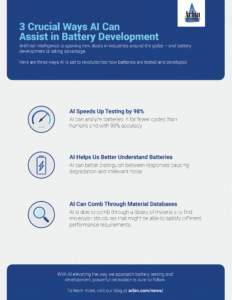
Artificial intelligence has been changing how the world works for many years now. From algorithms that optimize production, to voice activated virtual assistants on a smartphone or smart speaker, AI is able to optimize and automate processes to make them more efficient and productive. How can AI improve battery research and development? Here are three ways AI is set to revolutionize how batteries are tested and developed.
AI can speed up testing by 98%
Batteries are traditionally tested through repeated charge/discharge cycles. This allows researchers to see how battery performance deteriorates over time. However, it can take months for sufficient data to be collected for accurate predictions. This adds a lot of extra time to the testing process.
With AI, this process can speed up significantly. A joint research project between Stanford, MIT, and the Toyota Research Institute used AI to predict the life cycle of a battery. Using a few hundred million data points, researchers trained their AI to predict how many more cycles each battery would last. The AI was able to predict, within 9%, the number of cycles the cell eventually lasted. The machine could accomplish this just based on voltage declines and other factors in the first 100 charging cycles. Based on just the first five cycles, it was also able to predict whether the cell had a long or short battery life, with 95% accuracy. The AI was able to pick up patterns in the battery’s performance, much better than a human can manually.
The same team used this technology to find an optimized fast charging protocol. In this experiment, the researchers were able to find the best charging protocol for a battery chemistry, reducing a process that could usually take up to two years, to only 16 days. The AI was trained on data of battery failures, and, learning from this, was able to quickly determine the best protocols to test. Since there are many different ways to charge the same battery, the AI was able to predict how battery chemistry would react to a certain charging method, eliminate the ones most likely to fail, and test the ones most likely to succeed. With this, the AI offered researchers a simple protocol that they themselves would not have predicted. Not only does AI reduce the time it takes to get valuable results, it is able to think and solve problems in ways that people may not think of themselves, truly providing optimal solutions.
AI can help to better understand battery degradation
In a similar project, researchers from Cambridge and Newcastle Universities made use of a machine learning algorithm to not only predict battery health, but also detect and track patterns of degradation.
The research team developed a non-invasive way to monitor battery performance by sending electrical pulses at various levels of frequency into the cell and measuring the current at each frequency. These responses are processed by an AI trained with over twenty thousand measurements; the machine can determine which responses indicate battery degradation, and those that are irrelevant noise. The same strategy can be used on different battery chemistries and this data gives researchers a starting point to conduct experiments as to how and what causes battery degradation.
AI can comb through material databases
Another ingenious way AI is being used is in materials research. There are hundreds of thousands of molecules that could be viable candidates for a battery and the team at the US Department of Energy’s Joint Center for Energy Storage Research makes use of AI to find the best one.
Traditionally, if scientists suspect that a molecule could be appropriate for battery usage, they would have to place it inside a battery and test its performance. Now with machine learning, the AI is able to comb through a library of materials to find molecular structures that might be able to satisfy different performance requirements.
Similarly, scientists at Argonne National Laboratory are using AI to identify electrolyte materials.Their machine is trained to find molecules with desirable properties. While the algorithm has yet to find an option, when it does, scientists can use that material to create a test cell for experimentation, and with new sets of data, further refine the algorithm.
Battery scientists feel a sense of urgency to develop energy solutions to support a greener future and AI is playing an important role in streamlining and optimizing this process. With this technology, we may soon have a new and improved battery.

